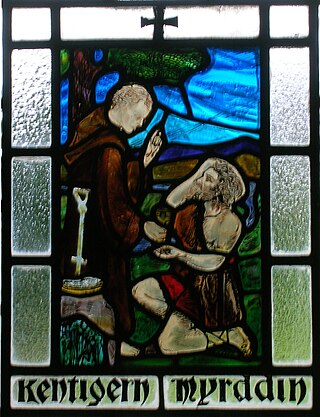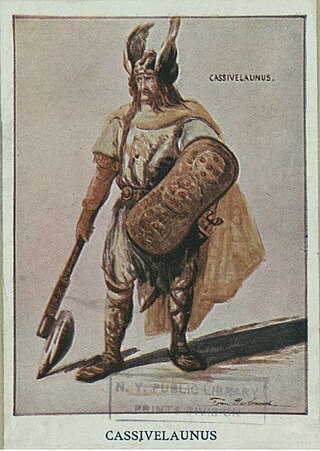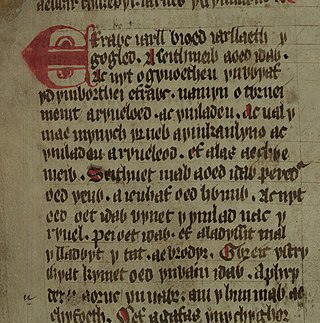Related Research Articles
Manawydan fab Llŷr is a figure of Welsh mythology, the son of Llŷr and the brother of Brân the Blessed and Brânwen. The first element in his name is cognate with the stem of the name of the Irish sea god Manannán mac Lir, and likely originated from the same Celtic deity as Manannán. Unlike Manannán, however, no surviving material connects him with the sea in any way except for his patronymic. Manawydan's most important appearances occur in the Second and Third Branches of the Mabinogi, but he is also referenced frequently in medieval poetry and the Welsh Triads.
Annwn, Annwfn, or Annwfyn is the Otherworld in Welsh mythology. Ruled by Arawn, it was essentially a world of delights and eternal youth where disease was absent and food was ever-abundant.

Gwyn ap Nudd is a Welsh mythological figure, the king of the Tylwyth Teg or "fair folk" and ruler of the Welsh Otherworld, Annwn, and whose name means “Gwyn, son of Nudd”. Described later on as a great warrior with a "blackened face", Gwyn is intimately associated with the otherworld in medieval Welsh literature, and is associated with the international tradition of the Wild Hunt.
In Welsh mythology, Gwythyr ap Greidawl was a rival of Gwyn ap Nudd, a deity connected with the otherworld. In the Middle Welsh prose tale Culhwch ac Olwen, he is named as a member of Arthur's retinue and takes part in the quest to win the hand of Olwen for Arthur's cousin, Culhwch. Gwthyr would join Arthur on a journey to Pennant Gofid in Hell to retrieve the blood of the witch Orddu. His father is Greidawl Galldonyd, a fellow knight in Arthur's court. In Bonedd yr Arwyr, his genealogy is given as Gwythyr son of Greidawl the son of Enfael the son of Deigyr the son of Dyfnwal the son of Ednyfed the son of Maxen the son of Llywelyn. The Welsh Triads name him as the father of Arthur's second wife, also named Gwenhwyfar.

Brân the Blessed is a giant and king of Britain in Welsh mythology. He appears in several of the Welsh Triads, but his most significant role is in the Second Branch of the Mabinogi, Branwen ferch Llŷr. He is a son of Llŷr and Penarddun, and the brother of Brânwen, Manawydan, Nisien and Efnysien. The name "Brân" in Welsh is usually translated as crow or raven.

Myrddin Wyllt is a figure in medieval Welsh legend. In Middle Welsh poetry he is accounted a chief bard, the speaker of several poems in The Black Book of Carmarthen and The Red Book of Hergest. He is called Wyllt—"the Wild"—by Elis Gruffydd, and elsewhere Myrddin Emrys ("Ambrosius"), Merlinus Caledonensis or Merlin Sylvestris("of the woods"). Myrddin Wylt was born in 540 CE.

Cassivellaunus was a historical British military leader who led the defence against Julius Caesar's second expedition to Britain in 54 BC. He led an alliance of tribes against Roman forces, but eventually surrendered after his location was revealed to Julius Caesar by defeated Britons.
The Thirteen Treasures of the Island of Britain are a series of items in late-medieval Welsh tradition. Lists of the items appear in texts dating to the 15th and 16th centuries. The number of treasures is always given as thirteen, but some later versions list different items, replacing or combining entries to maintain the number.

Peredur is the name of a number of men from the boundaries of history and legend in sub-Roman Britain. The Peredur who is most familiar to a modern audience is the character who made his entrance as a knight in the Arthurian world of Middle Welsh prose literature.

The Welsh Triads are a group of related texts in medieval manuscripts which preserve fragments of Welsh folklore, mythology and traditional history in groups of three. The triad is a rhetorical form whereby objects are grouped together in threes, with a heading indicating the point of likeness; for example, "Three things not easily restrained, the flow of a torrent, the flight of an arrow, and the tongue of a fool."

Welsh mythology consists of both folk traditions developed in Wales, and traditions developed by the Celtic Britons elsewhere before the end of the first millennium. As in most of the predominantly oral societies Celtic mythology and history were recorded orally by specialists such as druids. This oral record has been lost or altered as a result of outside contact and invasion over the years. Much of this altered mythology and history is preserved in medieval Welsh manuscripts, which include the Red Book of Hergest, the White Book of Rhydderch, the Book of Aneirin and the Book of Taliesin. Other works connected to Welsh mythology include the ninth-century Latin historical compilation Historia Brittonum and Geoffrey of Monmouth's twelfth-century Latin chronicle Historia Regum Britanniae, as well as later folklore, such as the materials collected in The Welsh Fairy Book by William Jenkyn Thomas (1908).
Lailoken was a semi-legendary madman and prophet who lived in the Caledonian Forest in the late 6th century. The Life of Saint Kentigern mentions "a certain foolish man, who was called Laleocen" living at or near the village of Peartnach (Partick) within the Kingdom of Strathclyde. Laleocen correctly prophesied the death of King Rhydderch Hael.
Dyfnwal Hen or Dumnagual Hen was a ruler of the Brittonic kingdom of Alt Clut, later known as Strathclyde, probably sometime in the early 6th century. His biography is vague, but he was regarded as an important ancestor figure for several kingly lines in the Hen Ogledd or "Old North" of Britain. As an ancestor figure, he compares to Coel Hen, another obscure figure credited with founding a number of northern dynasties.
Seithenyn sometimes known as Seithenyn of the feeble mind is a figure from Welsh legend, apparently contemporary with King Gwyddno Garanhir. He is mentioned in a poem in the Llyfr Du Caerfyrddin, but becomes the protagonist of the story in a later version of the legend, in which he was responsible for the sea-defences of Cantre'r Gwaelod or Maes Gwyddno, in the kingdom of the legendary Gwyddno Garanhir, but neglected them one night because of his drunkenness. Because of this neglect, the sea overran it.
Gwenddoleu ap Ceidio or Gwenddolau was a Brythonic king who ruled in Arfderydd. This is in what is now south-west Scotland and north-west England in the area around Hadrian's Wall and Carlisle during the sub-Roman period in Britain. Carwinley near Longtown north of Carlisle possibly derives from Cumbric Caer Wenddolau or Gwenddolau's Fort. The earthworks at Liddel Strength is also another contender for Caer Wenddolau.
Gwallog ap Lleenog was a hero of the Hen Ogledd. He has long been considered a probable sixth-century king of the sub-Roman state of Elmet in the Leeds area of modern Yorkshire, though some more recent scholarship would identify him more tentatively simply as a 'king of an unidentified region in the north'.
Talhaearn Tad Awen, was, according to medieval Welsh sources, a celebrated British poet of the sub-Roman period. He ranks as one of the earliest, if not the earliest, named poets to have composed and performed in Welsh. The better known poets Aneirin and Taliesin, who may have been slightly younger contemporaries, also belong to this early generation, the first of those known to modern scholars as the Cynfeirdd. Whereas medieval Welsh manuscripts preserve verse composed by or otherwise ascribed to the latter two figures, no such work survives for Talhaearn and in fact, his former fame seems to have largely vanished by the later Middle Ages.
According to Welsh tradition, Afaon fab Taliesin was the son of the bard Taliesin and a member of King Arthur's retinue. He appears both in the Welsh Triads and in the medieval Arthurian tale Breuddwyd Rhonabwy.
Henwen, meaning "Old White", is in Welsh legend a sow which according to the Welsh Triads gave birth to Cath Palug, a monstrous cat depicted as combating with either Cai or King Arthur of Arthurian Legends.

Cyfoesi Myrddin a Gwenddydd ei Chwaer is an anonymous Middle Welsh poem of uncertain date consisting of 136 stanzas, mostly in englyn form. Myrddin, the legendary 6th-century North British bard and warrior, is depicted as being encouraged by his sister Gwenddydd to utter a series of prophecies detailing the future history of the kings of Gwynedd, leading up to an apocalyptic ending. The mood of the poem has been described as "one of despair and of loss of faith and trust in this world".
References
- ↑ Bromwich, Rachel (1978) Trioedd Ynys Prydein: The Welsh Triads pp. 208–209. ISBN 0-7083-0690-X
- ↑ Bromwich pp. 469, 472
- ↑ Bromwich pp. 206–210.
- ↑ Tolstoy, Nikolai (1985) The Quest for Merlin, pp. 72–73. ISBN 0-241-11356-3
- ↑ Bromwich pp. 57–60, 65–67, 109–116
- ↑ The Dialogue of Myrddin and Taliesin
- ↑ Tolstoy p. 47
- ↑ The Dialogue of Gwyddno Garanhir and Gwyn ap Nudd